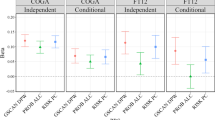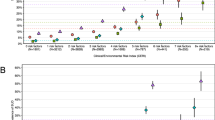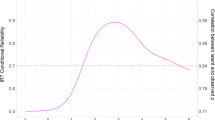Abstract
To determine the number of genetic factors underlying the Diagnostic and Statistical Manual of Mental Disorders, Fourth Edition (DSM-IV) criteria for alcohol dependence (AD), we conducted structural equation twin modeling for seven AD criteria, plus two summary screening questions, in 7133 personally interviewed male and female twins from the Virginia Adult Twin Study of Psychiatric and Substance Use Disorders, who reported lifetime alcohol consumption. The best-fit twin model required three genetic and two unique environmental common factors, and criterion-specific unique environmental factors. The first genetic factor was defined by high loadings for the probe question about quantity and frequency of alcohol consumption, and tolerance criterion. The second genetic factor loaded strongly on the probe question about self-recognition of alcohol-related problems and AD criteria for loss of control, desire to quit, preoccupation and activities given up. The third genetic factor had high loadings for withdrawal and continued use despite the problems criteria. Genetic factor scores derived from these three factors differentially predicted patterns of comorbidity, educational status and other historical/clinical features of AD. The DSM-IV syndrome of AD does not reflect a single dimension of genetic liability, rather, these criteria reflect three underlying dimensions that index risk for: (i) tolerance and heavy use; (ii) loss of control with alcohol associated social dysfunction and (iii) withdrawal and continued use despite problems. While tentative and in need of replication, these results, consistent with the rodent literature, were validated by examining predictions of the genetic factor scores and have implications for gene-finding efforts in AD.
This is a preview of subscription content, access via your institution
Access options
Subscribe to this journal
Receive 12 print issues and online access
$259.00 per year
only $21.58 per issue
Buy this article
- Purchase on Springer Link
- Instant access to full article PDF
Prices may be subject to local taxes which are calculated during checkout


Similar content being viewed by others
References
Goodwin DW, Schulsinger F, Hermansen L, Guze SB, Winokur G . Alcohol problems in adoptees raised apart from alcoholic biological parents. Arch Gen Psychiatry 1973; 28: 238–243.
Cloninger CR, Bohman M, Sigvardsson S . Inheritance of alcohol abuse. Cross-fostering analysis of adopted men. Arch Gen Psychiatry 1981; 38: 861–868.
Cadoret RJ, O’Gorman TW, Troughton E, Heywood E . Alcoholism and antisocial personality. Interrelationships, genetic and environmental factors. Arch Gen Psychiatry 1985; 42: 161–167.
Cadoret RJ, Troughton E, O’Gorman TW . Genetic and environmental factors in alcohol abuse and antisocial personality. J Stud Alcohol 1987; 48: 1–8.
Hrubec Z, Omenn GS . Evidence of genetic predisposition to alcoholic cirrhosis and psychosis: twin concordances for alcoholism and its biological end points by zygosity among male veterans. Alcohol Clin Exp Res 1981; 5: 207–215.
Pickens RW, Svikis DS, McGue M, Lykken DT, Heston LL, Clayton PJ . Heterogeneity in the inheritance of alcoholism. A study of male and female twins. Arch Gen Psychiatry 1991; 48: 19–28.
McGue M, Pickens RW, Svikis DS . Sex and age effects on the inheritance of alcohol problems: a twin study. J Abnorm Psychol 1992; 101: 3–17.
Heath AC, Bucholz KK, Madden PA, Dinwiddie SH, Slutske WS, Bierut LJ et al. Genetic and environmental contributions to alcohol dependence risk in a national twin sample: consistency of findings in women and men. Psychol Med 1997; 27: 1381–1396.
Kendler KS, Prescott CA, Neale MC, Pedersen NL . Temperance board registration for alcohol abuse in a national sample of Swedish male twins, born 1902 to 1949. Arch Gen Psychiatry 1997; 54: 178–184.
Kendler KS, Heath AC, Neale MC, Kessler RC, Eaves LJ . A population-based twin study of alcoholism in women. JAMA 1992; 268: 1877–1882.
Prescott CA, Kendler KS . Genetic and environmental contributions to alcohol abuse and dependence in a population-based sample of male twins. AJP 1999; 156: 34–40.
Prescott CA, Sullivan PF, Kuo P, Webb BT, Vittum J, Patterson DG et al. Genome-wide linkage study in the Irish Affected Sib Pair Study of Alcohol Dependence: evidence for a susceptibility region for symptoms of alcohol dependence on chromosome 4. Mol Psychiatry 2006; 11: 603–611.
Edenberg HJ, Koller DL, Xuei X, Wetherill L, McClintick JN, Almasy L et al. Genome-wide association study of alcohol dependence implicates a region on chromosome 11. Alcohol Clin Exp Res 2010; 34: 840–852.
Bierut LJ, Agrawal A, Bucholz KK, Doheny KF, Laurie C, Pugh E et al. A genome-wide association study of alcohol dependence. Proc Nat Acad Sci USA 2010; 107: 5082–5087.
Kendler KS, Kalsi G, Holmans PA, Sanders AR, Aggen SH, Dick DM et al. Genomewide association analysis of symptoms of alcohol dependence in the molecular genetics of schizophrenia (mgs2) control sample. Alcohol Clin Exp Res 2011; 35: 963–975.
Borges G, Ye Y, Bond J, Cherpitel CJ, Cremonte M, Moskalewicz J et al. The dimensionality of alcohol use disorders and alcohol consumption in a cross-national perspective. Addiction 2010; 105: 240–254.
Beseler CL, Taylor LA, Leeman RF . An item-response theory analysis of DSM-IV alcohol-use disorder criteria and ‘binge’ drinking in undergraduates. J Stud Alcohol Drugs 2010; 71: 418–423.
Saha TD, Chou SP, Grant BF . Toward an alcohol use disorder continuum using item response theory: results from the National Epidemiologic Survey on alcohol and related conditions. Psychol Med 2006; 36: 931–941.
Crabbe JC, Phillips TJ, Buck KJ, Cunningham CL, Belknap JK . Identifying genes for alcohol and drug sensitivity: recent progress and future directions. Trends Neurosci 1999; 22: 173–179.
Crabbe JC, Metten P, Cameron AJ, Wahlsten D . An analysis of the genetics of alcohol intoxication in inbred mice. Neurosci Biobehav Rev 2005; 28: 785–802.
Kendler KS, Prescott CA . Genes, Environment, and Psychopathology: Understanding the Causes of Psychiatric and Substance Use Disorders. 1st edn Guilford Press: New York, 2006.
Kendler KS, Prescott CA . A population-based twin study of lifetime major depression in men and women. Arch Gen Psychiatry 1999; 56: 39–44.
Spitzer RL, Williams JB, Gibbon J . Structured Clinical Interview for DSM-III-R-Patient Version (SCID-P, 4/1/87). New York State Psychiatric Institute: New York, 1987.
Guerrini I, Cook CC, Kest W, Devitgh A, McQuillin A, Curtis D et al. Genetic linkage analysis supports the presence of two susceptibility loci for alcoholism and heavy drinking on chromosome 1p22.1-11.2 and 1q21.3-24.2. BMC Genet 2005; 6: 11.
Neale MC, Boker SM, Xie G, Maes HH . Mx: Statistical Modeling, 6th edn. Department of Psychiatry Virginia Commonwealth University Medical School: Richmond, VA, 2003.
Little RJA, Rubin DB . Statistical Analysis with Missing Data. Wiley Series in Probability and Mathematical Statistics: Applied Probability and Statistics John Wiley & Sons, Inc.: New York, 1987.
Akaike H . Factor analysis and AIC. Psychometrika 1987; 52: 317–332.
Williams L, Holahan P . Parsimony-based fit indices for multiple-indicator models: do they work? Struct Equation Model 1994; 1: 161–189.
SAS Institute Inc. SAS OnlineDoc Version 9.1.3. SAS Institute Inc.: Cary, NC, 2002–2005.
Merikangas KR, Gelernter CS . Comorbidity for alcoholism and depression. Psychiatr Clin North Am 1990; 13: 613–632.
Kendler KS, Heath AC, Neale MC, Kessler RC, Eaves LJ . Alcoholism and major depression in women. A twin study of the causes of comorbidity. Arch Gen Psychiatry 1993; 50: 690–698.
Hicks BM, Krueger RF, Iacono WG, McGue M, Patrick CJ . Family transmission and heritability of externalizing disorders: a twin-family study. Arch Gen Psychiatry 2004; 61: 922–928.
Kendler KS, Aggen S, Knudsen GP, Roysamb E, Neale M, Reichborn-Kjennerud T . The structure of genetic and environmental risk factors for syndromal and subsyndromal common DSM-IV axis I and all axis II personality disorders. AJP 2011; 168: 29–39.
Sher KJ, Grekin ER, Williams NA . The development of alcohol use disorders. Annu Rev Clin Psychol 2005; 1: 493–523.
Muthen LK, Muthen BO . Mplus User's Guide: Sixth Edition; version 6.0, 6th edn., version 6.0 edn. Muthen & Muthen: Los Angeles, CA, 2010.
Prescott CA, Aggen SH, Kendler KS . Sex differences in the sources of genetic liability to alcohol abuse and dependence in a population-based sample of US twins. Alcohol Clin Exp Res 1999; 23: 1136–1144.
Babor TF . The classification of alcoholics: typology theories from the 19th century to the present. Alcohol Health Res World 1996; 20: 14.
Morey LC, Blashfield RK . Empirical classifications of alcoholism: a review. J Stud Alcohol 1981; 42: 925–937.
Cloninger CR . Neurogenetic adaptive mechanisms in alcoholism. Science 1987; 236: 410–416.
Babor TF, Hofmann M, DelBoca FK, Hesselbrock V, Meyer RE, Dolinsky ZS et al. Types of alcoholics I. Evidence for an empirically derived typology based on indicators of vulnerability and severity. Arch Gen Psychiatry 1992; 49: 599–608.
Bjork K, Hansson AC, Sommer WH . Genetic variation and brain gene expression in rodent models of alcoholism implications for medication development. Int Rev Neurobiol 2010; 91: 129–171.
Crabbe JC . Review. Neurogenetic studies of alcohol addiction. Philos Trans R Soc Lond B Biol Sci 2008; 363: 3201–3211.
Lovinger DM, Crabbe JC . Laboratory models of alcoholism: treatment target identification and insight into mechanisms. Nat Neurosci 2005; 8: 1471–1480.
Heilig M, Egli M, Crabbe JC, Becker HC . Acute withdrawal, protracted abstinence and negative affect in alcoholism: are they linked? Addict Biol 2010; 15: 169–184.
Crabbe JC, Kendler S, Hjaltason O . Modeling the diagnostic criteria for alcohol dependence with genetic animal models . Current Topics in Behavioral Neuroscience (CTN); Behavioural Neurobiology of Alcohol Addiction. Heidelberg: Springer, Germany, 2010.
Crabbe JC, Kosobud A, Young ER, Tam BR, McSwigan JD . Bidirectional selection for susceptibility to ethanol withdrawal seizures in Mus musculus. Behav Genet 1985; 15: 521–536.
Crabbe JC, Kosobud A . Sensitivity and tolerance to ethanol in mice bred to be genetically prone or resistant to ethanol withdrawal seizures. J Pharmacol Exp Ther 1986; 239: 327–333.
Metten P, Crabbe JC . Common genetic determinants of severity of acute withdrawal from ethanol, pentobarbital and diazepam in inbred mice. Behav Pharmacol 1994; 5: 533–547.
Crabbe JC, Janowsky JS, Young ER, Kosobud A, Stack J, Rigter H . Tolerance to ethanol hypothermia in inbred mice: genotypic correlations with behavioral responses. Alcohol Clin Exp Res 1982; 6: 446–458.
Ponomarev I, Crabbe JC . Characterization of acute functional tolerance to the hypnotic effects of ethanol in mice. Alcohol Clin Exp Res 2004; 28: 991–997.
Crabbe JC, Belknap JK, Mitchell SR, Crawshaw LI . Quantitative trait loci mapping of genes that influence the sensitivity and tolerance to ethanol-induced hypothermia in BXD recombinant inbred mice. J Pharmacol Exp Ther 1994; 269: 184–192.
Crabbe JC, Phillips TJ, Gallaher EJ, Crawshaw LI, Mitchell SR . Common genetic determinants of the ataxic and hypothermic effects of ethanol in BXD/Ty recombinant inbred mice: genetic correlations and quantitative trait loci. J Pharmacol Exp Ther 1996; 277: 624–632.
Phillips TJ, Lessov CN, Harland RD, Mitchell SR . Evaluation of potential genetic associations between ethanol tolerance and sensitization in BXD/Ty recombinant inbred mice. J Pharmacol Exp Ther 1996; 277: 613–623.
Gallaher EJ, Jones GE, Belknap JK, Crabbe JC . Identification of genetic markers for initial sensitivity and rapid tolerance to ethanol-induced ataxia using quantitative trait locus analysis in BXD recombinant inbred mice. J Pharmacol Exp Ther 1996; 277: 604–612.
Kirstein SL, Davidson KL, Ehringer MA, Sikela JM, Erwin VG, Tabakoff B . Quantitative trait loci affecting initial sensitivity and acute functional tolerance to ethanol-induced ataxia and brain cAMP signaling in BXD recombinant inbred mice. J Pharmacol Exp Ther 2002; 302: 1238–1245.
Schwarz G . Estimating the dimension of a model. Annual Statistics 1978; 6: 461–464.
Draper D . Assessment and propagation of model uncertainty. J R Stat Soc Ser B-Methodological 1995; 57: 45–97.
Raftery AE . Bayesian model selection in structural equation models. In: Bollen KA, Long JS, (eds). Testing Structural Equation Models, 1st edn. Sage: Newbury Park, CA, 1993, pp 163–180.
Kendler KS, Prescott CA, Jacobson K, Myers J, Neale MC . The joint analysis of personal interview and family history diagnoses: evidence for validity of diagnosis and increased heritability estimates. Psychol Med 2002; 32: 829–842.
Lessov CN, Martin NG, Statham DJ, Todorov AA, Slutske WS, Bucholz KK et al. Defining nicotine dependence for genetic research: evidence from Australian twins. Psychol Med 2004; 34: 865–879.
Acknowledgements
This study was supported in part by Grants AA011408, AA017828, AA10760 and AA13519 from the National Institute of Health (NIH) and a Grant from the US Department of Veterans Affairs. The NIH and the US Department of Veterans Affairs had no direct role in the design or conduct of the study or in the collection, management, analysis and interpretation of the data, and did not review or approve this manuscript. KSK had full access to all of the data in the study and takes responsibility for the integrity of the data and the accuracy of the data analysis. Linda Corey, PhD, provided assistance with the ascertainment of twins from the Virginia Twin Registry, now part of the Mid-Atlantic Twin Registry (MATR). The MATR, now directed by Judy Silberg, PhD, has received support from the NIH, the Carman Trust, the WM Keck, John Templeton and Robert Wood Johnson Foundations, and Grant UL1RR031990 from the National Center for Research Resources. Pamela Metten, PhD, and Andy Cameron BS provided assistance with the rodent correlational analyses. We thank Pamela Metten and John Belknap, PhD, for access to unpublished data.
Author information
Authors and Affiliations
Corresponding author
Ethics declarations
Competing interests
The authors declare no conflict of interest.
PowerPoint slides
Rights and permissions
About this article
Cite this article
Kendler, K., Aggen, S., Prescott, C. et al. Evidence for multiple genetic factors underlying the DSM-IV criteria for alcohol dependence. Mol Psychiatry 17, 1306–1315 (2012). https://doi.org/10.1038/mp.2011.153
Received:
Revised:
Accepted:
Published:
Issue Date:
DOI: https://doi.org/10.1038/mp.2011.153
Keywords
This article is cited by
-
Ethanol withdrawal-induced dysregulation of neurosteroid levels in plasma, cortex, and hippocampus in genetic animal models of high and low withdrawal
Psychopharmacology (2017)
-
FKBP5 Moderates Alcohol Withdrawal Severity: Human Genetic Association and Functional Validation in Knockout Mice
Neuropsychopharmacology (2014)
-
The Genetics, Neurogenetics and Pharmacogenetics of Addiction
Current Behavioral Neuroscience Reports (2014)
-
What psychiatric genetics has taught us about the nature of psychiatric illness and what is left to learn
Molecular Psychiatry (2013)
-
Genetic and Neurophysiological Correlates of the Age of Onset of Alcohol Use Disorders in Adolescents and Young Adults
Behavior Genetics (2013)



